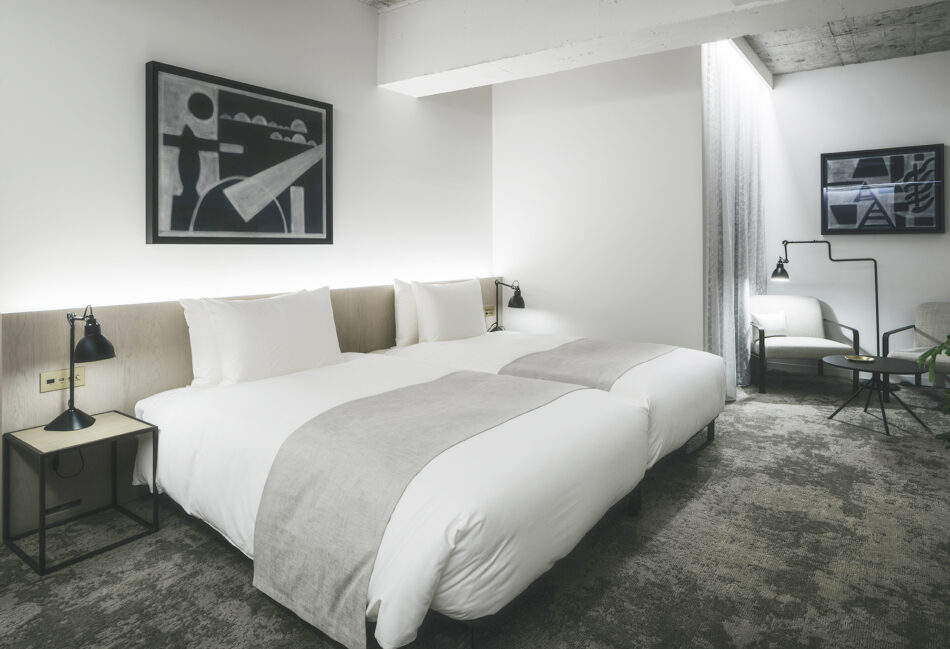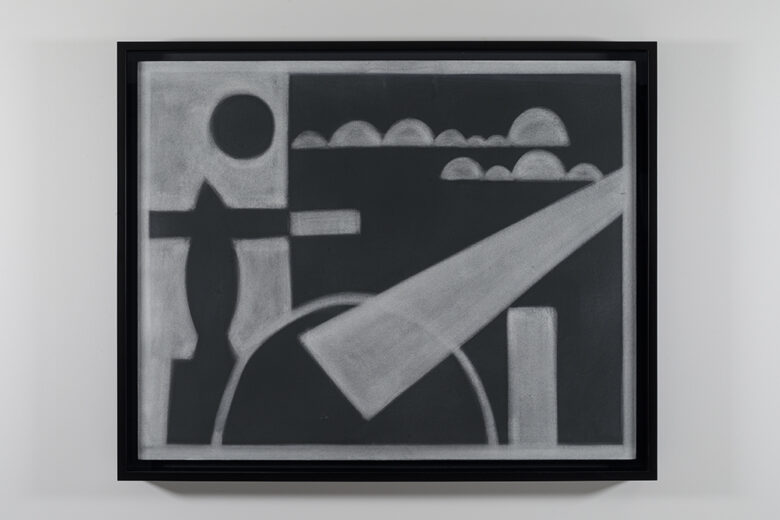ROOM 17 Silke Otto-Knapp / シルケ・オットー・ナップ 村上華子 / HANAKO MURAKAMI

Silke Otto-Knapp / シルケ・オットー・ナップ

Composition

Landscape (with moon and clouds)
1970年、オスナブリュック(ドイツ)生まれ。ロサンゼルスを拠点に活動。ヒルデスハイム大学(ドイツ)でカルチュラルスタディーズを専攻、その後ロンドン芸術大学チェルシー・カレッジ・オブ・アート・アンド・デザインで修士号を取得。主な個展に、「In the Waiting Room」(2020年、ルネッサンス・ソサイエティ、シカゴ)、「スミレ」(2018年、タカ・イシイギャラリー、東京)、「Bühnenbilder」(2017年、ミッドウェイ・コンテンポラリー・アート、ミネアポリス)など。主なグループ展に、「Performer and Participant」(2019年、テート・モダン、ロンドン)、「リバプール・ビエンナーレ2018:Beautiful world, where are you?」(2018年、ロンドン)、「第9回イスタンブール・ビエンナーレ」(2005年、イスタンブール)など。作品は、ニューヨーク近代美術館、テート・モダン、サンフランシスコ近代美術館などにコレクションされている。
シルケ・オットー・ナップは、舞台やモダン・ダンスの歴史を参照したモチーフを、キャンバスに水彩絵の具を用いて描き、独特の奥行きを持った絵画作品で知られている。一度画面につけた絵の具を落としながら描く事で、平面的でありながらも、複雑な絵画空間が生まれている。制限されたモノクロームの色彩によって、古い白黒写真のネガのような空間と時間を圧縮したような印象を与え、また特有の物質感を生み出している。《Composition》は、ダダイズム運動に参加し、インスタレーションの先駆けと言える「メルツ建築」等を提唱したクルト・シュビッタース(1887年〜1948年)の詩誌名を出発点に制作されている。シュビッタースの構想した「ノーマルビューネ(標準的な舞台)」は、どのような脚本や作品形態にもあう舞台装置として、立方体、球、円、階段など抽象的な形態を用いた舞台空間として提唱された。シンプルな形状と奥行きや錯覚を用いて、多様な見え方を生み出す表現をモチーフにして描かれた本作は、鑑賞者の記憶や経験によって、都市や身の回りの風景にも見える。シュヴィッタースの目指した空間を絵画空間において体現しているようである。
Silke Otto-Knapp was born in Germany in 1970. She is now based in Los Angeles. She majored in Cultural Studies at the University of Hildesheim and received her MFA from Chelsea College of Art and Design, University of the Arts London. Her major solo exhibitions include In the Waiting Room (Renaissance Society, Chicago, 2020), Violets (Taka Ishii Gallery, Tokyo, 2018), and Bühnenbilder (Midway Contemporary Art, Minneapolis, 2017). Her major group exhibitions include Performer and Participant (Tate Modern, London, 2019), Liverpool Biennial 2018: Beautiful world, where are you?, and the 9th International Istanbul Biennial (2005). Her works are in the collections of institutions including the New York Museum of Contemporary Art, the Tate Modern, and the San Francisco Museum of Modern Art.
Silke Otto-Knapp is known for paintings with a unique sense of depth, created with watercolours on canvas and exploring imagery related to the history of theatre and modern dance. Her technique involves applying paint to the canvas and then removing or repositioning it, fostering the emergence of a planar yet complex pictorial space.By restricting herself to a monochrome palette, she also creates a unique sense of materiality that imparts an impression of compressed time and space in the manner of old black-and-white film negatives. Composition is named after a poetry magazine published by Kurt Schwitters (1887–1948). Schwitter was a Dadaist who pioneered the installation as art. His concept of the Normalbühne (normal theatre) envisaged a theatrical space in which abstract forms like cubes, balls, circles, and stairs served as stage apparatus to meet the needs of any script or play.
Otto-Knapp’s painting uses simple forms, depth, and illusion to create imagery that expresses diverse perspectives. Depending on the viewer’s own memories or experiences, it may suggest a cityscape, or perhaps everyday surroundings. It is an embodiment in pictorial space of the kind of space Schwitters sought to create.
村上華子 / HANAKO MURAKAMI

Untitled(ROC-P 19.5.15, I/Sp/C)
1984年生まれ。現在はパリを拠点に活動。2007年、東京大学文学部卒業、2009年に東京藝術大学大学院映像研究科修士課程修了。その後、2011年にベルギー政府奨学生として渡欧、2013年にポーラ美術振興財団在外研修でパリに滞在。2014年には、ル・フレノワ: フランス国立現代アートスタジオで学ぶ。主な個展に、「クリテリオム96 村上華子」(2019年、水戸芸術館、茨城)、「ANTICAMERA (OF THE EYE)」(2016年、タカ・イシイギャラリー、東京)、「資本空間ースリー・ディメンショナル・ロジカル・ピクチャーの彼岸 vol.2 村上華子」(2015年、ギャラリーαM、東京)など。主なグループ展に、「抽象に挑む写真」(2020年、FRAC ノルマンディー・ルーアン美術館、フランス)、「Arles 2019: New Discovery Award」(2019年、Arles, les Rencontres de la photographie)「VOCA展2017」(2017年、上野の森美術館、東京)、「TOKYO STORY」(2010年、トーキョーワンダーサイト、東京)など。
村上は、写真の古典技法や活版印刷技術など、過去の技術やメディアに焦点を当て、綿密なリサーチに基づいて写真やテキストによる作品を制作する事で知られている。本作は、写真黎明期の技術の一つ「カロタイプ」の発明で知られるタルボット(英、1800−1877)が、その発明以前に試みていた技法「イオタイプ」を用いている。1840年頃とされる「カロタイプ」の発明に至る試行錯誤の過程で生まれた「イオタイプ」は、ものの姿を写し取る点には成功したが、光に当てることで徐々に消えてしまうため実用化に至らなかった幻の技法である。実物は残っていないため、本作はタルボットが書き残した手記や書簡をもとに制作された。そこには、光によって描かれたものが光によって少しずつ消されていくという、写真のジレンマが凝縮されていると言えるだろう。
Hanako Murakami was born in 1984. After receiving her Bachelor of Literature from the University of Tokyo, she received her MA from the Tokyo University of the Arts, Department of New Media. She continued her studies for a year in Belgium with a government scholarship. With a grant from the Pola Art Foundation, she then moved to France, where she joined Le Fresnoy National Studio of Contemporary Art in 2014.
Her major solo exhibitions include The Capital Room: Beyond Three Dimensional Logical Pictures: Hanako Murakami (Gallery αM, Tokyo, 2015), ANTICAMERA (OF THE EYE) (Taka Ishii Gallery, Japan, 2016), and CRITERIUM 96: Hanako Murakami (Art Tower Mito, Ibaraki, 2019).
Her major group exhibitions include Tokyo Story (Tokyo Wonder Site, 2010), VOCA: The Vision of Contemporary Art (Ueno Royal Museum, Tokyo, 2017), Arles 2019: New Discovery Award (Les Rencontres de la photographie, Arles, 2019), and La Photo à l’épreuve de l’abstraction (FRAC Normandie Rouen, France, 2020).
Murakami is known for creating works using photographs and text based on in-depth research into the technologies and media of the past, including classical photography techniques and letterpress printing. This work uses iotype, a technique explored by William Henry Fox Talbot (1800-1877) before he invented the famous early photographic process of calotype. Iotype was an early result of the the experimental trial and error that led to the calotype’s invention. Now all but forgotten, it succeeded in capturing images, but was found impractical because its prints gradually faded when exposed to light. Since Talbot’s original apparatus is no longer extant, this work was created based on his notes and letters. In its images drawn in light yet gradually erased by light itself, this work encapsulates the dilemma of photography.

